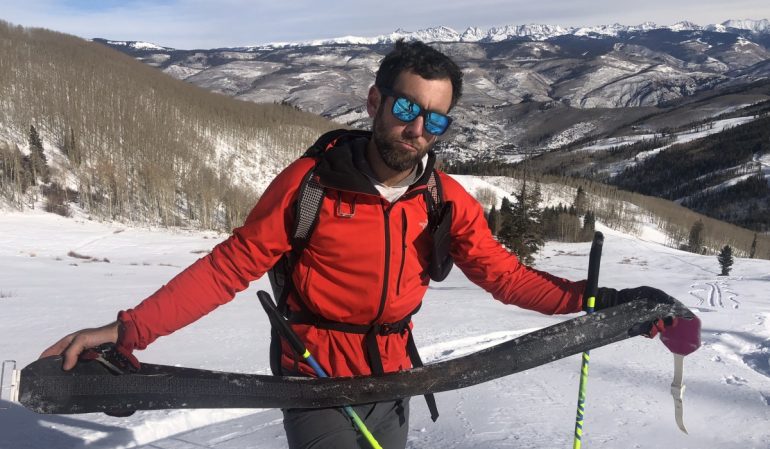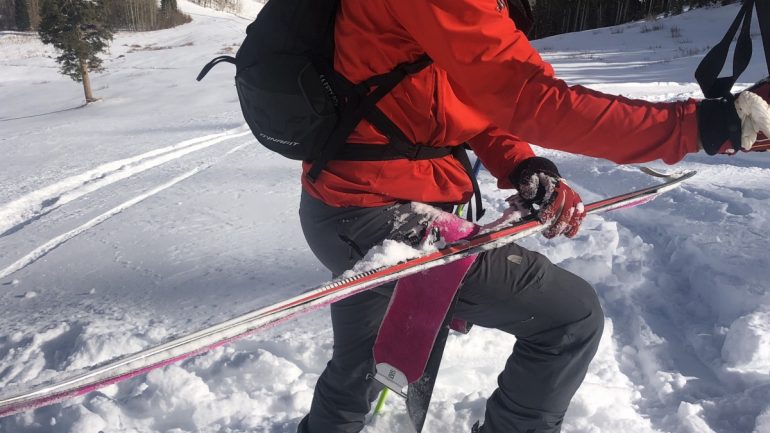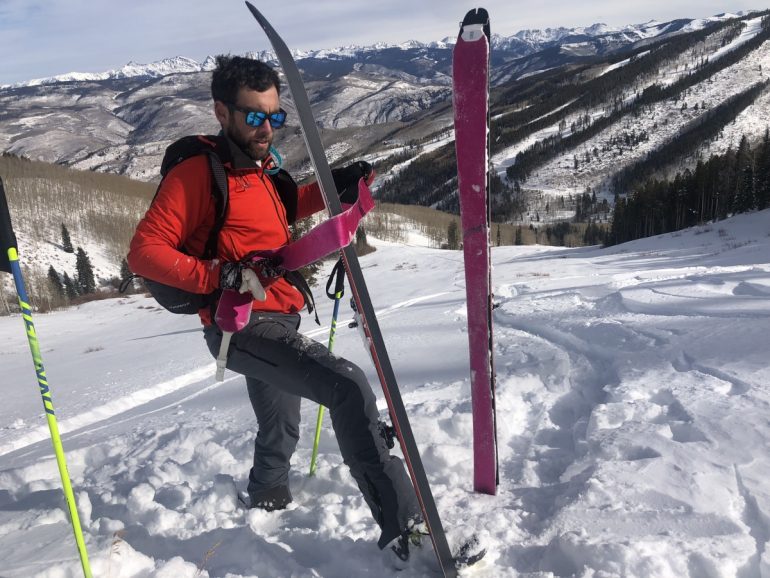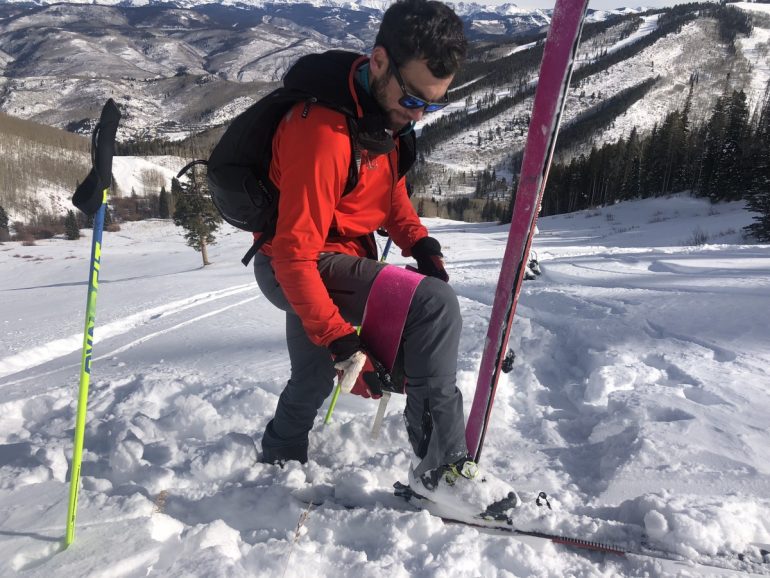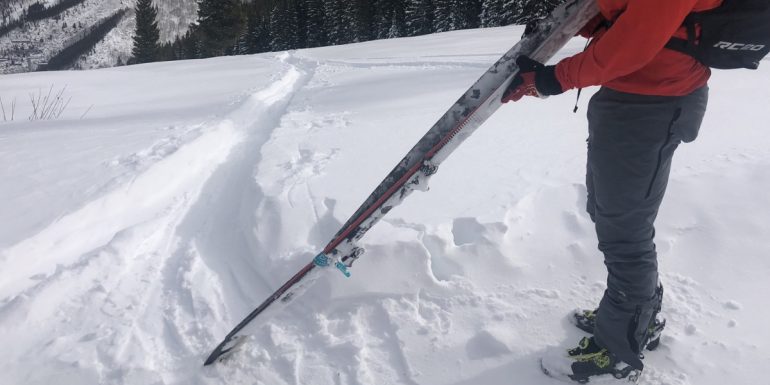As we approach the spring season, it’s good to be reminded of ways to keep climbing skins happy. Here are a few tips from the archives to ensure you get the most out of your skins this spring season.
Skins hit the fan? Here’s what to do
Your connection to Mother Earth on the up: your magic carpets to get the goods, your beloved climbing skins. You spent good cash on them and they do so much for you, so let’s commit to keeping them happy and healthy in the field this season. And while we’re at it, let’s consider how to revive them in the event of drama.
Skin performance starts in the days and weeks headed up to your backcountry mission, so I encourage you to rewind and reread Doug’s musings on TLC for your touring hides. Read on for what to do when things get epic.
First, a recap on skin basics. Which ones?
Nylon, mohair, traditional glue or new-fangled “glueless.” We’ve covered this recently on WildSnow, but my preference over the years has been a nylon-mohair blend for most days. Recall that I’ve been a Colorado-based skier for most of my life, with forays to Canuckistan and Europe. In a refrozen spring skintrack, I’ll opt for a pure nylon skin if I have it. Racing with the manorexics in the dark at A-Basin? Pure mohair. But day in and day out, I like the enhanced glide and acceptable climbing prowess of a 70/30 skin, like the Pomoca Climb Pro-S Glide.
As for glue? I tried one of the original “glueless” models, the Geckos, way back when, and a few others since. The newer Contour offering, “Hybrid Mix,” blends mohair and nylon and one of these miraculous non-glue adhesives to weld the things to the ski’s bases — and I had 20 successful days on them last year. Worth looking into.
My takeaway from the glue debate boils down to this: glueless skins still require care, just in a different way, and old-school still works fine. My experience has been that Euro glue doesn’t like super-low humidity (Colorado, yo!) and single-digit temps. I supplement with Black Diamond glue on the tip and tail of Euro skins. The glueless options are getting better and better, but they’re not care-free.
But I digress! We are here for skin revivals and in-field performance! Onward!
Preventing full climbing skin failure
Leave the trailhead with happy skins. Good glue, adhered to a clean ski base, trimmed to fit, pre-waxed if you’re worried at all about moisture in the snow.
Once on the up, keep an eye on your skin hygiene. Are you clumping? Did you plunge a tail on a turn and force snow between skin and ski? Ideally we avoid problems in the first place, but error-correcting early will prevent Full Skin Failure (FSF).
Kick turns in particular can invite carnage if you’re plunging your tail in the snow. Without a tail clip and very good glue, you are asking to peel your skin tail up. Kick turns, being one-hundred-percent evil, should be avoided if possible (more on this another time, but expert terrain selection ending in a rounded walking turn is faster and easier!), but when the time comes, demonstrate your loose and supple hips and avoiding plunging your tail. If you do plunge the tail, glance to make sure you didn’t just take the first step towards FSF.
Failure detected: first steps to deal
Because you are so fit, relaxed, and have panoramic awareness at all times, you immediately notice slight drama developing (SDD) with one or both skins. Your first decision is: stop now, or wait ‘til your next transition? On a warm-ish day (20-31.8F), with dry snow, you can probably get away with some housekeeping at your next transition. If though, your SDD threatens to become FSF, stop immediately. Tell your Lycra-clad, uber-skinny touring partner to sit down and have a no-cal popcorn cake and diet water while you fix your skin. A moment of attention now will save cursing and frustration later.
Remount
You might first just pop off your ski, brush the adhesive base gently, and clear any snow from the ski base, then remount. How’s it look, good? Your buddy will still be munching his satisfying treat by the time you’re on the move. Attack while he has popcorn lodged in his throat; he would do the same to you.
Edge Scrape
OK, so the remount didn’t work and you’re now at defcon 3, nearing FSF. Time to get aggressive. Stop, remove the offending ski/skin. Separate the skin from the ski, mutter an incantation. In the toe of the boot of Italy, I have heard grandmothers threaten to make a broth from the bones of their enemies’ dead ancestors. Something along these lines.
Now, plunge the ski upright into the snow, with the base facing away from you. Make sure it’s stable. Hold the skin tip with one hand, the tail with the other, with the glue side facing you. Loop it over the ski, so you now have the skin’s glue side facing the base of the ski. Tension the skin around the ski, then saw the skin back and forth. You’re dragging the skin’s glue along the skis’s edges, scraping any ice or snow from the skin.
Do this back and forth repeatedly, until the skin is snow/ice-free. Remount and see how it works. On the next descent, I would strongly recommend stashing the skin inside your jacket to rewarm it. If the skin is in FSF mode, you might even have to sit down and rewarm the skin to keep climbing. On a sub-zero (F) day with no humidity in the air, you might have to do this just to finish the climb.
Edge scraping typically works for mid-winter/cold-dry skin problems. The technique usually solves ice build up and dry pow problems. Skin saturation/spring problems, now that’s a different beast. More on this in a moment.
Rewarming
Like a hypothermic human, iced-up skins require immediate rewarming. In severe cases, too much snow between the skin and ski, or just ice build up, will demand time inside the jacket. On your next descent, clean the skin as much as you can, removing ice and snow, then fold it glue-on-glue, and wrap around your mid-section as many layers deep as is practicable. Zip up, ski, and hopefully the radiating warmth of your chiseled abs will have rehabilitated the skins by the time you’ve concluded your run.
If you attempt the abdominal rewarm, remember, your skins can slide out the bottom of your jacket. Want to never get invited touring again? Yeah, you feel me. Stash your skins and tighten your pack’s waist belt. Losing both your iced-up skins on a pow day and post-holing six miles back to the car is not desirable.
Send the gnar, dry your ski bases as best you can, remount the skins, and you’re back on the uptrain to Radville.
What if…? Triage steps for full skin failure
What if you can’t finish the climb, even after rewarming, and casting a most-foul spell upon the skin? You are now officially into Atomic Full Skin Failure (AFSF). Way to go, again, dude. Anyway, you must now deploy any of several unsavory strategies to continue the climb. Most of them involve denying yourself any glide whatsoever.
First, take one or two ski straps and lash your skin to your ski. Often our skin problems start from the tail forward, so put one ski strap somewhere on your ski tail, then one near your heel piece. Hopefully you have a heel clip you can tighten a smidge, just to lock the skin in place. Do your best.
No ski straps, you say?! You are a rare breed indeed, touring without ski straps. We are an inclusive crew on the WildSnow, though, so no shame (but WTF?). Duct tape can be used to lash on a skin or two, but it’s a temporary fix and won’t work nearly as well as the ski straps you don’t have. Try anyway.
I’m sure somebody somewhere has used bailing wire, cordelette, or maybe elk tendon, but these are even worse options than duct tape, so avoid at all costs. But leave a comment if you use ‘em.
Other issues
Lost Skin?
Those of you who owned a Pontiac Aztek when it debuted (2001) or attended a concert with any of the popular boy bands (‘N Sync, New Kids on the Block, Backstreet Boys, etc.) of the 1990s are simply cursed with bad judgment and even worse luck. You’re the type who might just lose a skin entirely in deep pow. Your friends will threaten to abandon you. Better know how to deal, and fast.
Five or six ski straps, all lashed around your ski will provide uphill grip, a surprising amount, actually. Do it, quick. I also heard tale of a gent who affixed several pine branches lengthwise down the base, with ski straps. Another friend once saw a guy leave the hut in Europe, get a few hundred meters down the slope, only to realize he’d forgotten his skins. He macramed one cordelette around each ski so sufficiently he could climb back to the hut. His friends eventually made a broth from the bones of his dead enemies and made him drink it through his nostrils.
Ski Scraper (and Wet Problems)
You savvy shredders all tour with a ski scraper stashed handily in a pocket, I trust. Good! You can clean your bases, and even skins, with one. Make a habit of a quick glance at your bases at each transition if you sense there might be snow or ice building up. Clean it firmly and at once with your scraper.
In the spring, skins can get mighty bitchy once soaked with water. Again, some quick work on the front end will save you much of this problem. Wax your skins before heading out and then carry a small block of skin wax with you in the field.
If you sense your skins are taking on water (they will not only get heavier, they will probably loosen up a bit — nylon stretches when wet), then at your next transition, take your ski scraper and run it down the length of the skin to “squeegee” out any water. On one of Colorado’s epic spring days, you’ll be amazed how much water you can get out of the skin.
Once you do that, it’s probably worth running your block of skin wax over the skin to dissuade more water from soaking in. In severe cases, run the wax both directions, with and against the plush. Rewax them once they’re dry, before your next tour. I prefer a warm iron with wax on it over the spray-in stuff. No clue on the “eco” waxes out there at present. I should try them.
Conclusions
And now, dear friends, I turn it over to you. The Comments section on WildSnow should be converted into its own reference volume(s), so I look forward to learning what all of you are doing to revive skins in the field.
Again, start the day with cared-for skins and most of this gibberish is moot. If you do, however, run into drama, I hope you’ve got a few more tools to deal.
Rob Coppolillo is WildSnow’s official Mud Season Correspondent. He recently moved to Chamonix, France, with his wife and twin punks, Dominic and Luca. His ski stuff has been sequestered on a dock in Marseille. Much emailing has done little to liberate the ski stuff. He *might* ski this season, but it’s out of his hands. He is an IFMGA-certified mountain guide and owns Vetta Mountain Guides. His next book, The Ski Guide Manual, comes out November, 2020.
Rob Coppolillo is a mountain guide and writer, based on Vashon Island, in Puget Sound. He’s the author of The Ski Guide Manual.

